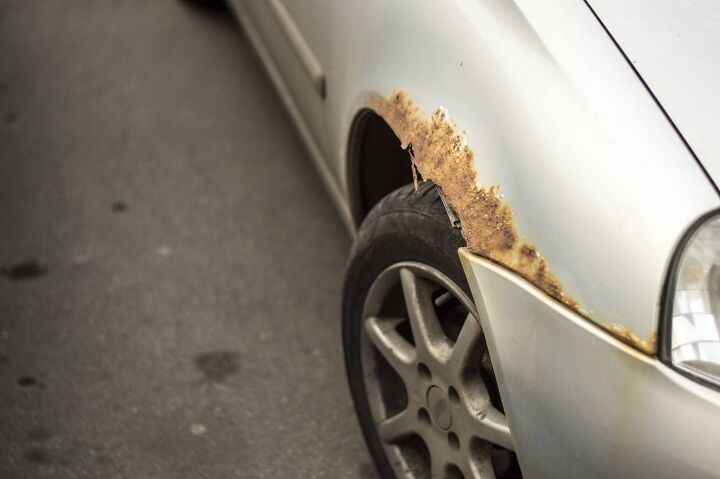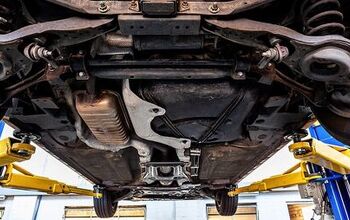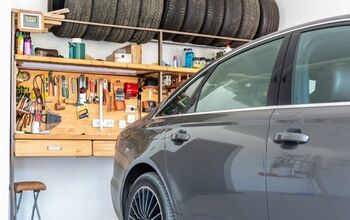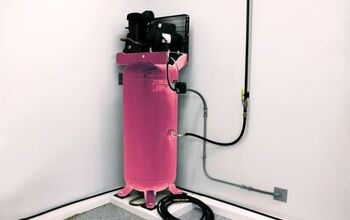The Best Rust Inhibitors for Your Garage

It’s virtually inevitable: over the course of months and years, rust will begin to form on your car, truck, or crossover. Left unchecked, it’ll spread, expand, and eventually ruin its finish, structural integrity, and more.
Rust can form virtually anywhere: in obvious locations on the painted surface of your vehicle, deep beneath its floor, within its body panels, or even completely hidden from sight behind plastic trim and weather stripping. When rust begins forming, it’s hard to stop and very invasive.
Thankfully, numerous products are available to help slow or stop the formation of rust in and on your vehicle. So are several accessories that may help protect your vehicle and prevent rust from forming in the first place. Read on for the scoop about rust protection for whatever you drive, and remember: not all rust-protection products are created equal.
Table of contents
- 1. Editor's Pick: Rust Converter Ultra
- 2. CRC White Lithium Grease Spray
- 3. WD-40 Specialist Long Term Corrosion Inhibitor
- 4. Fluid Film Protectant and Lubricant
- 5. JENOLITE Waxoil Spray
- Bonus: Electronic Rust Protection
- How Rust is Created
- What’s the best way to prevent rust?
- Do Electronic Rust Modules Actually Work?
- General How-To Use Tips
- How to remove rust from your car by Kshitij Sharma
- Equipment you will need
- The Procedure
- Recent Updates:
1. Editor's Pick: Rust Converter Ultra
To use it, simply clean existing rust scale from the area you want to treat, leaving as clean and debris-free a surface as possible. Then, apply the product with a brush or roller. Rust is neutralized and transformed into a dark coating. Once set, the coating acts as a primer, and can be painted for added protection.
The one-gallon jug is ideal for larger projects, and many users report that a single jug is sufficient to coat the entire frame of a pickup truck. Rust Converter Ultra can also be used on metal railings, outdoor furniture, and more. It’s cost-effective, durable, and easy to use.
Pros | Effective protection from the spread and growth of existing rust, easy to use, economical |
Cons | Doesn’t prevent new rust from forming in new areas, needs existing rust to work, won’t protect bare metal |
2. CRC White Lithium Grease Spray
This type of rust inhibitor is commonly used on a regular basis to seal, lubricate and protect trunk and tailgate release latches, gears, tracks, power window slider components, throttle cables, rust-prone suspension mounting points, sunroof assemblies, and more.
Typically used for spot application, lithium grease is somewhat costly per unit, but the benefits are numerous: the product has a buttery, paste-like texture and is designed to stay in place without dripping or running. A waterproof, corrosion-protecting seal is left behind, and the white color makes it easy to see where it’s been applied. For strategic spot lubrication and rust prevention, White Lithium Grease Spray is a go-to.
User reviews commonly praise the product’s viscosity — which is thick enough to stay in place without worry, but also thin enough to absorb into smaller gaps.
Pros | Lubricates and protects, easy to apply, long-lasting protection that won’t drip or run |
Cons | Relatively expensive, not suitable for all applications |
3. WD-40 Specialist Long Term Corrosion Inhibitor
From the makers of the world’s most famous rust-penetrating lubricant comes WD-40 Long Term Corrosion Inhibitor. The makers of WD-40 know a thing or two about dealing with rust and this product features a special formulation variant to help keep that rust from forming or spreading.
Designed to coat metal parts with lubrication and rust prevention, it works for up to 2 years when used indoors and up to 1 year when used outside. The special formula clings to metal and seals out moisture and air—which are two of the ingredients needed for rust to form.
A precision straw applicator is included to minimize waste and overspray, and the liquid won’t dry over time or run. This special formulation of WD-40 is ideal for spot application or for use on more widespread areas preemptively to prevent rust from forming.
Pros | Legendary WD40 performance and expertise, product stays in place and won’t run, useful for spot or widespread application |
Cons | Non-permanent and will require occasional reapplication, relatively expensive for wide-area usage |
4. Fluid Film Protectant and Lubricant
For big and highly involved rust-protection jobs, look no further than Fluid Film Protectant and Lubricant. Available in value-sized one-gallon cans, this highly-rated product is perfect for the DIY enthusiast with a big rust-protection job to tackle. For best results, you may wish to use an air-compressor-powered spray gun, though some users apply the product with a brush or roller.
Fluid Film is a highly-rated brand, and their by-the-gallon Protectant and Lubricant is ideal for covering large areas quickly and easily. Owner reviews say that one gallon is roughly sufficient to thickly coat the underside of a large pickup. The product also lubricates hinges, chains, and cables, and contains no solvents, so it won’t damage paint or rubber parts.
Pros | Affordable wide-area coverage, reputable brand, easy to use on virtually all applications |
Cons | Potentially messy |
5. JENOLITE Waxoil Spray
One of this editor's best friends hails from the UK but now calls California home. The best thing about California, he says, is that cars don't rust there. Jenolite Waxoil rust-preventative spray comes from the UK, where they really need such products.
Waxoil Spray is a thick, waxy mist that can be applied to exposed metal anywhere. It's especially useful for wheel arches, chassis components, suspension members, and the inside of steel box-section assemblies like doors or sills. The manufacturer says that the rust-preventing Waxoil coating will self-heal if it receives minor damage. Jenolite doesn't talk about its special formula, but the name makes us think lanolin is likely one of the components.
User satisfaction was generally very high; well over 80%, in fact. There were a few complaints about canisters arriving with damaged spray nozzles, and at least one user complained that the waxy coating collected dirt. It should be noted that products like this are really meant to be used in out-of-the-way areas where function counts more than appearance.
Bonus: Electronic Rust Protection
Electronic rust protection works on the principle of conducting an electrical current through the vehicle’s metal body to interrupt the rust formation process at the molecular level. Though the technology has been widely used in marine and underground tank applications for years, its effectiveness has been widely debated in the automotive world for some time. Products like the Fin Corrosion Control module are discreet and easy to install quickly, but owner reviews of electronic rust protection products, in general, are mixed at best. (See notes from one of our experts below.)
Do your homework first. If you decide to use a product like this one, simple ‘set it and forget it’ installation takes mere minutes.
Pros | Promise of full-vehicle corrosion control, easy to install, inexpensive relative to promised benefits, universal fitment |
Cons | Debatable effectiveness |
How Rust is Created
Rust forms when water molecules react with the iron found in the metal that makes up most of your vehicle’s body and structure. It’s created by a chemical reaction that literally transforms the ingredients involved, creating a new compound called an ‘oxide’, which weakens the metal and leaves an unsightly mess.
What’s the best way to prevent rust?
Further, note that surface rust typically forms rapidly when the paint is compromised with a deep chip or scratch. As such, timely and effective sealing of the vehicle’s painted surfaces, if damaged, goes a long way to keep rust from spreading.
Do Electronic Rust Modules Actually Work?
“Electronic rust protection works, though it’s designed for applications like underground fuel tanks and large boats,” says Jeff Major, a collision repair technician. “Thing is, in those applications, the metal exterior surface is always wet or damp, allowing the signal to conduct powerfully and fully throughout the metal structure or body.”
Major works in Northern Ontario, where vehicles are exposed to large amounts of salt. When he repairs vehicles with body damage, he takes note of whether or not they have a rust module installed. Then, he inspects the body, beneath the body panels, for signs of rust.
Major’s hobby has led to an interesting observation. “I’ve yet to see a car with a rust module installed that isn’t rusting,” he says. “I was working on a new Corolla the other day that had a rust module installed at the dealership. This car hadn’t even seen its first oil change yet, and it had a rust module but was already showing some rust. In my opinion, these just don’t work as advertised. I haven’t been proven wrong, yet, and I wouldn’t waste my money on one.”
General How-To Use Tips
Clean It First: Though the instructions in the rust inhibitor you’re using should be followed precisely, it’s typically a good idea to remove any dirt, debris, or loose existing rust from the area you want to protect before applying the product.
Choose the Right Product: Rust inhibitors are available in a multitude of general-use and application-specific formulations, each with a different purpose. Assess the rust area you want to address, and choose the right product for the job. If you’ll be applying the product on the exterior or underside of your vehicle, you’ll want to use a product designed not to wash away or drip. Thinner or more ‘runny’ rust inhibitors are generally best used for areas protected from exposure to the elements.
Preventative Maintenance: One of the best ways to keep your vehicle rust-free is to help stop rust from forming in the first place. Keeping your vehicle clean, regularly washing its undercarriage with fresh water in winter months, and preventing dirt, mud, leaves and debris from accumulating in or on its body are all great ways to discourage rust from forming. Treat paint chips and scratches on metal surfaces right away for even better results.
Read the Warnings: Don’t skip the warning label on the rust inhibitor you’re using. Some formulations can damage your vehicle’s paint, wiring insulation, rubber seals, and more. Not all rust inhibitors are compatible with all parts of your car or truck—so be sure to carefully read the warnings for best results.
How to remove rust from your car by Kshitij Sharma
If we were to compare rust to a disease, it will likely be cancer. It spreads rapidly if the conditions are right, if untreated it can destroy a body panel. And if you don’t get it repaired on time, it can even eat through the chassis rendering the car undrivable and sometimes outright dangerous. Many cars have been written off due to excessive rust. So if you notice your car is developing rust despite your best efforts, ensure you get it treated immediately. You can even treat rust at home but bear in mind you do need some automotive experience and know-how to treat the rust at home. So without further ado, here is how you can remove rust from your car at home.
Equipment you will need
Plastic Sheeting– To cover the vehicle and avoid damage to the area around the rust affected patch.
Painter’s tape– again as an added layer of protection for the unaffected areas.
Sandpaper– 180 or 320 grit to sand away the rust. You will need much more aggressive grit sandpaper in case the rust is deeper than the surface.
A grinder tool– again depends on the type and depth of rust
Wax and grease remover– To clean the affected area before you apply the primer or clear coat.
Body filler– to fill the areas that have been sanded away.
Paint matching the car color– for obvious reasons
Protective gear– Latex gloves, dust mask, and protective goggles to protect you from the fine dust and paint fumes.
Before we begin the procedure, there’s one thing you need to ascertain, the type of rust you are planning to treat. There are three types of rust that you will encounter, surface rust, scale rust and penetrating rust. Surface rust, as the name suggests is just on the surface of the metal. This is the initial stage where the rust has just begun to settle in and it is relatively easy to tackle if you treat it at this stage. You will rarely require a power tool to treat surface rust.
The second type of rust is called scale rust. This is when the rust has settled into the metal and has caused the metal to pit. You will need to be more aggressive in your approach to treat this type of rust and will require the grinder tool to get the rust out. You will need a lot more body filler as well.
The third type of rust is penetrating rust and as the name suggests, it is the type that causes holes in the metal. And there is no going back from this stage. If you have penetrating rust, that body panel will need replacement.
The Procedure
Surface rust
- The first step is to prep your car. Cover the car with the plastic sheet to protect it from the fine dust that will blow momentarily. Leave out the area where you will be working with a few inches of space on each side. Also, ensure you choose a hot day as it will help with the drying process. Anything below 65 degrees is a no go.
- Next, don your gear. Make sure your mask is airtight, the goggles fit well and your gloves are snug on your hands.
- Before you get to the sanding, clean the area with wax and grease remover. Yes, you are about to sand the area anyway but any foreign material, if not cleaned can compromise the metal.
- Commence sanding. Use the fine-grit sandpaper and sand on the rust patch until you reach the metal. You can also use a rust remover spray before you commence sanding. Spray, leave for 20 minutes and then wipe the rust away with a cloth. The leftover rust will need to be sanded down. The rust remover is highly corrosive so be careful when handling it. However, we recommend you use the sanding method.
- Once the shiny metal has been exposed, clean the area again with the wax and grease remover. Now it’s time for the primer and paint.
- Using rust prevention paint is recommended as you will not need a separate primer. Pray the primer in smooth motion onto the exposed metal and let it dry for about 30 minutes. Next, you will need to scuff the primer with ultra-fine grit sandpaper until its smooth to touch.
- Clean the surface again and apply the car paint. Before you apply the paint practice on a piece of cardboard with different motions and distance to get the right finish. Another point to note is to not wax your car for at least 3-4 weeks.
Note: You don’t need body filler for surface rust.
Scale Rust
With scale rust, follow the surface rust steps till step 3 where you clean the surface with the wax and grease remover. For the next step you will need the grinder tool
- You will need to grind out the dust using a 2” or a 3” grinding disc mounted to a right angle grinder. You may need to start with a more aggressive 36 grit disc to remove the heavier scales and then move to a 120 grit to remove the remaining rust and the surrounding paint.
- Next, you may or may not use a prep step solution to clean the exposed metal. Solutions like the Zero-Rust prep step help remove dirt and fine debris from the sanded area and help prep it for the next step. You can also simply use a grease remover and a microfiber cloth to rid the area of fine dust.
- Next, use the body filler to fill the depression in the bodywork and let it cure or dry.
- Smooth out the body filler using fine-grit sandpaper, preferably a 180 grit. Keep going to a finer grit till 600 until the fill is smooth to touch and all the sanding grooves are no longer visible.
- Clean the surface again with the wax and grease remover.
- Next, you will need to apply two coats of the primer on the prepped surface. Ensure you use smooth motions and spread the primer evenly. Also, ensure that you apply the second coat only after the first is dry.
- Use the 600 grit sandpaper and sand until smooth. Now apply the automotive paint as the final coat. You can go for two coats as well. Just ensure the paint matches the rest of the car. Finally, buff with the microfiber cloth once the paint is dry.
- Do not wax for 3-4 weeks after the process.
Recent Updates:
November 23, 2022: Removed Dupli-Color touchup paint; added Waxoil spray. Updated product descriptions and links.
We are committed to finding, researching, and recommending the best products. We earn commissions from purchases you make using the retail links in our product reviews. Learn more about how this works.
Photo credit: Alfred Koal / Shutterstock.com

Justin Pritchard, an award-winning automotive journalist based in Sudbury, Ontario, is known for his comprehensive automotive reviews and discoveries. As a presenter, photographer, videographer, and technical writer, Justin shares his insights weekly through various Canadian television programs, print, and online publications. In 2023, Justin celebrated a significant milestone, airing the 600th episode of his TV program, AutoPilot. Currently, he contributes to autoTRADER.ca, Sharp Magazine, and MoneySense Magazine. His work as a technical writer, videographer, presenter, and producer has been recognized with numerous awards, including the 2019 AJAC Video Journalism Award and the 2018 AJAC Journalist of the Year. Justin holds a Bachelor of Commerce (Hons) from Laurentian University, which he earned in 2005. His career in automotive journalism began that same year at Auto123.com. Since then, he has written one of the largest collections of used car buyer guides on the internet. His passion for photography, nurtured from a young age, is evident in his work, capturing the scenic beauty of Northern Ontario. Living in a region with a particularly harsh winter climate has made Justin an expert on winter driving, winter tires, and extreme-weather safety. Justin’s significant achievements include: 2019 AJAC Video Journalism Award (Winner) 2019 AJAC Road Safety Journalism Award (Runner-Up) 2019 AJAC Automotive Writing (vehicle review topics) (Winner) 2019 AJAC Automotive Writing (technical topics) (Winner) 2018 AJAC Journalist of the Year You can follow Justin’s work on Instagram @mr2pritch and YouTube @JustinPritchard.
More by Justin Pritchard










































Comments
Join the conversation